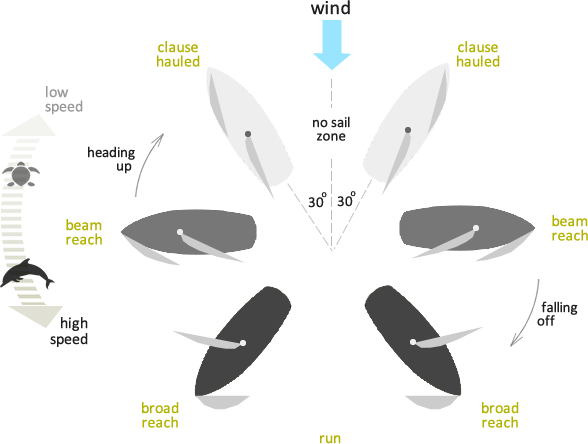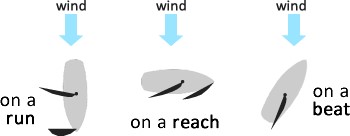Points of sail
Introduction to Points of Sail
Understanding the points of sail is crucial for every sailor, as it dictates how a sailboat maneuvers in relation to the wind.
The term "points of sail" refers to the different angles a boat can sail relative to the wind direction.
In this article, we will explore each point of sail and discuss the reasons behind a boat's orientation in relation to the wind, ultimately aiming at mastering the wind.

Understanding Sailboat Orientation

The orientation of a sailboat in relation to the wind is crucial for efficient sailing and achieving the desired course.
The reasons behind a boat's orientation depend on various factors, including sail trim, boat design, wind direction, and desired speed.
🔵 In Irons: No Forward Movement
When a sailboat is "in irons," it means the boat is directly into the wind, causing the sails to luff and the boat to stall.
This position is marked by a lack of forward movement and minimal control over the boat's direction.
Sailors aim to avoid being in irons whenever possible, as it hinders progress and maneuverability.
🔵 On a Run
Refers to the sailing condition where the boat is moving with the wind directly from behind, also known as sailing "downwind".
In this situation, the sails are fully opened to capture as much wind as possible, but the boat is essentially drifting with the wind's speed.

This results in less strain on the sheets and rigging, as the wind is pushing the boat forward gently.
🔵 On a Reach
Refers to sailing with the wind coming from the side.
Depending on the exact angle of the wind, there are three types of reaches:
- Close reach
The wind is coming from the forward side, approximately at a 60°-75° angle to the boat. - Beam reach
The wind is coming from directly to the side, at a 90° angle to the boat.
This is one of the fastest and most stable points of sail. - Broad reach
The wind is coming from the aft side, approximately at a 120°-150° angle to the boat.
🔵 On a Beat
Refers to sailing as close to the wind as possible, typically at an angle of about 45° to the direction from which the wind is coming. This is also known as "close-hauled"
The sails are pulled in tight to the centerline of the boat to maximize the lift and allow the boat to move upwind.
Sailing on a beat requires skill and strategy, as the boat needs to tack, or zigzag, to make progress against the wind.
Efficient Use of Sails
Sailboats are designed to harness the power of the wind efficiently.
By adjusting the sails and boat orientation, sailors can optimize the airflow over the sails, maximizing propulsion while minimizing drag.
Each point of sail requires specific sail trim and boat positioning to achieve optimal performance.
Balancing Speed and Stability
The orientation of a sailboat also affects its speed and stability.
- Close hauled and beam reach positions offer increased speed but may sacrifice some stability due to heeling.
- Broad reach and running positions provide more stability but may sacrifice some speed compared to sailing closer to the wind.
Adapting to Wind Conditions
Sailboat orientation is also influenced by wind conditions.
In light winds, sailors may need to sail closer to the wind to maintain forward momentum, while in strong winds, sailing off the wind allows for faster and more comfortable sailing.
Understanding how wind conditions affect sailboat orientation is essential for safe and efficient sailing.
Navigating Obstacles
The orientation of a sailboat is crucial for navigating obstacles and avoiding collisions.
By adjusting the boat's position relative to the wind, sailors can maneuver around obstacles more effectively and safely.
Sailboat orientation plays a vital role in collision avoidance and overall seamanship.
Conclusion
Mastering the points of sail and understanding sailboat orientation are fundamental skills for every sailor.
By knowing how to sail effectively at different angles to the wind and understanding the reasons behind sailboat orientation, sailors can navigate confidently and efficiently in various wind conditions, ensuring a safe and enjoyable sailing experience.

